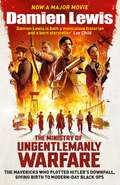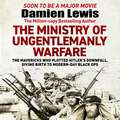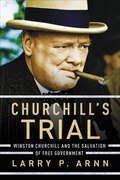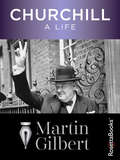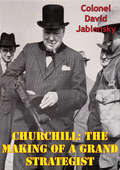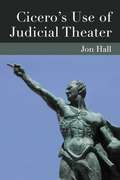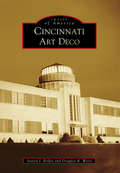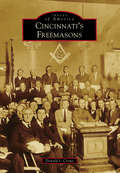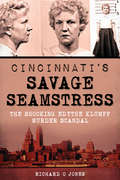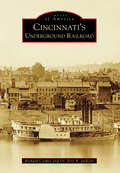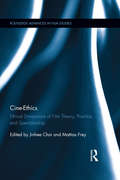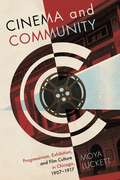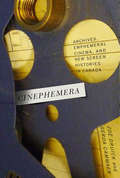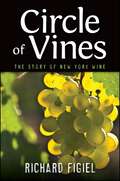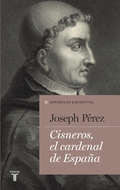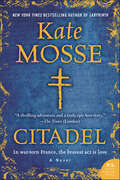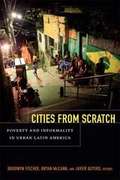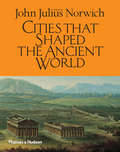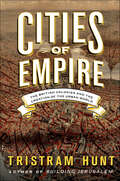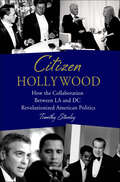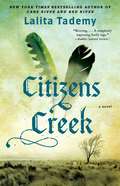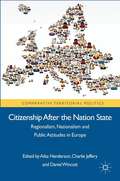- Table View
- List View
Churchill's Secret Warriors: The Explosive True Story of the Special Forces Desperadoes of WWII
by Damien LewisOne of the most remarkable stories in the history of Special Forces' operations - Daily ExpressIn the bleak moments after defeat on mainland Europe in winter 1939, Winston Churchill knew that Britain had to strike back hard. So Britain's wartime leader called for the lightning development of a completely new kind of warfare, recruiting a band of eccentric free-thinking warriors to become the first 'deniable' secret operatives to strike behind enemy lines, offering these volunteers nothing but the potential for glory and all-but-certain death. Churchill's Secret Warriors tells the story of the daring victories for this small force of 'freelance pirates', undertaking devastatingly effective missions against the Nazis, often dressed in enemy uniforms and with enemy kit, breaking all previously held rules of warfare. Master storyteller Damien Lewis brings the adventures of the secret unit to life, weaving together the stories of the soldiers' brotherhood in this compelling narrative, from the unit's earliest missions to the death of their leader just weeks before the end of the war.
Churchill's Secret Warriors: The Explosive True Story of the Special Forces Desperadoes of WWII
by Damien LewisOne of the most remarkable stories in the history of Special Forces' operations - Daily ExpressIn the bleak moments after defeat on mainland Europe in winter 1939, Winston Churchill knew that Britain had to strike back hard. So Britain's wartime leader called for the lightning development of a completely new kind of warfare, recruiting a band of eccentric free-thinking warriors to become the first 'deniable' secret operatives to strike behind enemy lines, offering these volunteers nothing but the potential for glory and all-but-certain death. Churchill's Secret Warriors tells the story of the daring victories for this small force of 'freelance pirates', undertaking devastatingly effective missions against the Nazis, often dressed in enemy uniforms and with enemy kit, breaking all previously held rules of warfare. Master storyteller Damien Lewis brings the adventures of the secret unit to life, weaving together the stories of the soldiers' brotherhood in this compelling narrative, from the unit's earliest missions to the death of their leader just weeks before the end of the war.
Churchill's Secret Warriors: The Explosive True Story of the Special Forces Desperadoes of WWII
by Damien LewisIn the bleak moments after defeat on mainland Europe in winter 1939, Winston Churchill knew that Britain had to strike back hard. So Britain's wartime leader called for the lightning development of a completely new kind of warfare, recruiting a band of eccentric free-thinking warriors to become the first 'deniable' secret operatives to strike behind enemy lines, offering these volunteers nothing but the potential for glory and all-but-certain death. Churchill's Secret Warriors tells the story of the daring victories for this small force of 'freelance pirates', undertaking devastatingly effective missions against the Nazis, often dressed in enemy uniforms and with enemy kit, breaking all previously held rules of warfare. Master storyteller Damien Lewis brings the adventures of the secret unit to life, weaving together the stories of the soldiers' brotherhood in this compelling narrative, from the unit's earliest missions to the death of their leader just weeks before the end of the war.(P)2014 WF Howes Ltd
Churchill's Trial: Winston Churchill and the Salvation of Free Government
by Larry P. ArnnNo statesman shaped the twentieth century more than Winston Churchill. To know the full Churchill is to understand the combination of boldness and caution, of assertiveness and humility, that defines statesmanship at its best. With fresh perspective and insights based on decades of studying and teaching Churchill, Larry P. Arnn explores the greatest challenges faced by Churchill over the course of his extraordinary career, both in war and peace—and always in the context of Churchill&’s abiding dedication to constitutionalism.Churchill&’s Trial is organized around the three great challenges to liberty that Churchill faced: Nazism, Soviet communism, and his own nation&’s slide toward socialism. Churchill knew that stable free government, long enduring, is rare, and hangs upon the balance of many factors ever at risk. Combining meticulous scholarship with an engrossing narrative arc, this book holds timely lessons for today. Arnn says, &“Churchill&’s trial is also our trial. We have a better chance to meet it because we had in him a true statesman.&”In a scholarly, timely, and highly erudite way, Larry Arnn puts the case for Winston Churchill continuing to be seen as statesman from whom the modern world can learn important lessons. In an age when social and political morality seems all too often to be in a state of flux, Churchill&’s Trial reminds us of the enduring power of the concepts of courage, duty, and honor.--Andrew Roberts, New York Times bestselling author of Napoleon: A Life and The Storm of WarLarry Arnn has spent a lifetime studying the life and accomplishments of Winston Churchill. In his lively Churchill&’s Trial, Arnn artfully reminds us that Churchill was not just the greatest statesman and war leader of the twentieth century, but also a pragmatic and circumspect thinker whose wisdom resonates on every issue of our times.--Victor Davis Hanson, senior fellow, The Hoover Institution, Stanford UniversityIn absorbing, gracefully written historical and biographical narration, Larry Arnn shows that Churchill, often perceived as inconsistent and opportunistic, was in fact philosophically rigorous and consistent at levels of organization higher and deeper than his detractors are capable of imagining. In Churchill&’s Trial Arnn has rendered great service not only to an incomparable statesman but to us, for the magnificent currents that carried Churchill through his trials are as admirable, useful, and powerful in our times as they were in his.--Mark Helprin, New York Times bestselling author of Winter&’s Tale and In Sunlight and in ShadowChurchill&’s Trial, a masterpiece of political philosophy and practical statesmanship, is the one book on Winston Churchill that every undergraduate, every graduate student, every professional historian, and every member of the literate general public should read on this greatest statesman of the twentieth century. The book is beautifully written, divided into three parts–war, empire, peace–and thus covers the extraordinary life of Winston Churchill and the topics which define the era of his statesmanship. --Lewis E. Lehrman, cofounder of the Lincoln and Soldiers Institute at Gettysburg College and distinguished director of the Abraham Lincoln Association
Churchill: A Life
by Martin Gilbert&“A richly textured and deeply moving portrait of greatness&” (Los Angeles Times). In this masterful book, prize-winning historian and authorized Churchill biographer Martin Gilbert weaves together the research from his eight-volume biography of the elder statesman into one single volume, and includes new information unavailable at the time of the original work&’s publication. Spanning Churchill&’s youth, education, and early military career, his journalistic work, and the arc of his political leadership, Churchill: A Life details the great man&’s indelible contribution to Britain&’s foreign policy and internal social reform. With eyewitness accounts and interviews with Churchill&’s contemporaries, including friends, family members, and career adversaries, it provides a revealing picture of the personal life, character, ambition, and drive of one of the world&’s most remarkable leaders. &“A full and rounded examination of Churchill&’s life, both in its personal and political aspects . . . Gilbert describes the painful decade of Churchill&’s political exile (1929–1939) and shows how it strengthened him and prepared him for his role in the &‘hour of supreme crisis&’ as Britain&’s wartime leader. A lucid, comprehensive and authoritative life of the man considered by many to have been the outstanding public figure of the 20th century.&” —Publishers Weekly &“Mr. Gilbert&’s job was to bring alive before his readers a man of extraordinary genius and scarcely less extraordinary destiny. He has done so triumphantly.&” —The New York Times Book Review
Churchill: The Making Of A Grand Strategist
by Colonel David JablonskyStrategy is the calculated relationship of means to ends. At the highest military level, that relationship guides the use of the joint and combined military instrument of power to achieve national military strategic objectives. At the national or grand strategic level, the relationship becomes more complex, dealing with multiple, interrelated objectives that can only be achieved by the coordinated use of all the instruments of national power, to include that of the military. In a rapidly changing, increasingly more complicated and interdependent world, the U.S. military professional needs to understand not only the dynamics of military strategy, but of grand strategy as well.This book examines the evolution of Winston Churchill's understanding of both strategic dynamics. In the author's view, that understanding came about not so much from any detailed, consistent study of great strategists or immutable strategic principles, but rather from on-the-job strategic training throughout an incredibly rich and varied life. In the military sphere, there were at first only his tactical experiences in the small wars in the closing years of the Victorian era. In the First World War, however, Churchill came to appreciate the operational and military strategic levels of war as well. Moreover, it was that conflict which drew him increasingly to the realm of grand strategy in which all the elements of national power were combined to achieve victory in the first total war of this century.
Cicero's Use Of Judicial Theater
by Jonathan HallIn Cicero's Use of Judicial Theater, Jon Hall examines Cicero's use of showmanship in the Roman courts, looking in particular at the nonverbal devices that he employs during his speeches as he attempts to manipulate opinion. Cicero's speeches in the law-courts often incorporate theatrical devices including the use of family relatives as props during emotional appeals, exploitation of tears and supplication, and the wearing of specially dirtied attire by defendants during a trial, all of which contrast strikingly with the practices of the modem advocate. Hall investigates how Cicero successfully deployed these techniques and why they played such a prominent part in the Roman courts. These "judicial theatrics" are rarely discussed by the ancient rhetorical handbooks, and Cicero's Use of Judicial Theater argues that their successful use by Roman orators derives largely from the inherent theatricality of aristocratic life in ancient Rome--most of the devices deployed in the courts appear elsewhere in the social and political activities of the elite. While Cicero's Use of Judicial Theater will be of interest primarily to professional scholars and students studying the speeches of Cicero, its wider analyses, both of Roman cultural customs and the idiosyncratic practices of the courts, will prove relevant also to social historians, as well as historians of legal procedure.
Cicero: Pro Archia Poeta Oratio (Annotated Latin Collection)
by Cicero Steven M. Cerutti Gaby HuebnerNIMAC-sourced textbook
Cincinnati Art Deco
by Douglas R. Weise Steven J. RolfesArt Deco, daring and almost defiant in its optimism, reflected the spirit of a restless time. Bursting forth in the midst of the Roaring Twenties, an age when there seemed to be no limits, this new art form was both elegant and modern. Cincinnati is fortunate to have three stunning examples of this unique style: the sophisticated Hilton Netherland Plaza hotel, the overwhelming Cincinnati Times-Star Building, and the Union Terminal. Beyond these giants, the Greater Cincinnati region is studded with many other breathtaking examples of Art Deco, from a water tower decorated with Christmas lights to stunning neighborhood theaters and apartment buildings to mythological creatures guarding a Masonic temple in northern Kentucky. There is no doubt that Art Deco is alive and well in Cincinnati, so grab a hip flask of bathtub gin, put on some Glenn Miller, and explore the elegance and history of Cincinnati Art Deco.
Cincinnati's Freemasons
by Donald I. CrewsThe first Masonic lodge in Cincinnati was chartered in 1791, less than three years after the town's founding. Many prominent Cincinnatians have devoted their time, money, and effort to the fraternity. Many have also found knowledge, fulfillment, and camaraderie within the main and appendant bodies of the brotherhood. This book offers an introduction to the order's members, buildings, and related organizations in southwest Ohio. The contributions of the Queen City's share of the world's oldest and largest fraternity are revealed through images from lodges and other bodies, buildings, individuals, and numerous other sources.
Cincinnati's Savage Seamstress: The Shocking Edythe Klumpp Murder Scandal (True Crime)
by Richard O JonesOn a cold, drizzly fall afternoon in 1958, a trio of duck hunters stumbled on the charred remains of Cincinnati resident Louise Bergen. When investigators learned that her estranged husband was living with an older divorcee, Edythe Klumpp, they wasted no time in questioning her. When she failed a lie detector test, Edythe spilled out a confession. Although it did not fit the physical evidence, she was found guilty and sentenced to death in the electric chair. Governor Michael V. DiSalle put his political career on the line to save Edythe from the death penalty, personally interviewing the prisoner while she was under the influence of "truth serum." But was it the truth? Richard O Jones separates the facts from the fiction in this comprehensive book about the Klumpp murder.
Cincinnati's Underground Railroad (Images of America)
by Richard Cooper Dr Eric JacksonNearly a century after the American Revolution, the waters of the Ohio River provided a real and complex barrier for the United States to navigate. While this waterway was a symbol of freedom and equality for thousands of enslaved black Americans who had escaped from the horrible institution of enslavement, the Ohio River was also used to transport thousands of slaves down the river to the Deep South. Due to Cincinnati's location on the banks of the river, the city's economy was tied to the slave society in the South. However, a special cadre of individuals became very active in the quest for freedom undertaken by African American fugitives on their journeys to the North. Thanks to spearheading by this group of Cincinnatian trailblazers, the "Queen City" became a primary destination on the Underground Railroad, the first multiethnic, multiracial, multiclass human-rights movement in the history of the United States.
Cine-Ethics: Ethical Dimensions of Film Theory, Practice, and Spectatorship (Routledge Advances in Film Studies)
by Jinhee Choi Mattias FreyThis volume looks at the significance and range of ethical questions that pertain to various film practices. Diverse philosophical traditions provide useful frameworks to discuss spectators’ affective and emotional engagement with film, which can function as a moral ground for one’s connection to others and to the world outside the self. These traditions encompass theories of emotion, phenomenology, the philosophy of compassion, and analytic and continental ethical thinking and environmental ethics. This anthology is one of the first volumes to open up a dialogue among these diverse methodologies. Contributors bring to the fore some of the assumptions implicitly shared between these theories and forge a new relationship between them in order to explore the moral engagement of the spectator and the ethical consequences of both producing and consuming films
Cinema and Community: Progressivism, Exhibition, and Film Culture in Chicago, 1907-1917
by Moya LuckettCaught between the older model of short film and the emerging classic era, the transitional period of American cinema (1907-1917) has typically posed a problem for studies of early American film. Yet in Cinema and Community: Progressivism, Exhibition, and Film Culture in Chicago, 1907-1917, author Moya Luckett uses the era's dominant political ideology as a lens to better understand its cinematic practice. Luckett argues that movies were a typically Progressive institution, reflecting the period's investment in leisure, its more public lifestyle, and its fascination with celebrity. She uses Chicago, often considered the nation's most Progressive city and home to the nation's largest film audience by 1907, to explore how Progressivism shaped and influenced the address, reception, exhibition, representational strategies, regulation, and cultural status of early cinema. After a survey of Progressivism's general influences on popular culture and the film industry in particular, she examines the era's spectatorship theories in chapter 1 and then the formal characteristics of the early feature film-including the use of prologues, multiple diegesis, and oversight-in chapter 2. In chapter 3, Luckett explores the period's cinema in the light of its celebrity culture, while she examines exhibition in chapter 4. She also looks at the formation of Chicago's censorship board in November 1907 in the context of efforts by city government, social reformers, and the local press to establish community standards for cinema in chapter 5. She completes the volume by exploring race and cinema in chapter 6 and national identity and community, this time in relation to World War I, in chapter 7. As well as offering a history of an underexplored area of film history, Luckett provides a conceptual framework to help navigate some of the period's key issues. Film scholars interested in the early years of American cinema will appreciate this insightful study.
Cinephemera
by Zoë Druick Gerda CammaerWhat do digital platforms mean for cinema studies in Canada? In an era when digital media are proliferating and thousands upon thousands of clips are available online, it seems counter-intuitive to say that audio-visual history is quickly disappearing. But the two processes are actually happening in tandem. Adopting a media-archaeological approach to the history of cinema, contributors to Cinephemera cover a wide range of pressing issues relating to Canadian cinema's ephemerality, including neglected or overlooked histories, the work of found footage filmmakers, questions about access and copyright, and practices of film archiving. Spurred by rapid changes to technologies of production, viewing, and preservation, this collection showcases both leading and emerging scholars grappling with the shifting meaning of cinema as an object of study. Film historians are put in conversation with experimental filmmakers and archivists to provide renewed energy for cinema studies by highlighting common interests around the materiality and circulation of films, videos, and other old media. Considering a wide range of cases from the earliest days of silent film production to the most recent initiatives in preservation, Cinephemera exposes the richness of moving image production in Canada outside the genres of feature length narrative fiction and documentary - a history that is at risk of being lost just as it is appearing. Contributors include Andrew Burke (Winnipeg), Jason Crawford (Champlain), Liz Czach (Alberta), Seth Feldman (York), Monika Kin Gagnon (Concordia), André Habib (Montreal), Randolph Jordan (SFU), Peter Lester (Brock), Scott Mackenzie (Queen's); Louis Pelletier (Montreal), Katherine Quanz (WLU), Micky Story (New College), Charles Tepperman (Calgary), Jennifer VanderBurgh (Saint Mary's), William C. Wees (McGill), Jerry White (Dalhousie), and Christine York (Concordia).
Cinephemera: Archives, Ephemeral Cinema, and New Screen Histories in Canada
by Zoë Druick Gerda CammaerWhat do digital platforms mean for cinema studies in Canada? In an era when digital media are proliferating and thousands upon thousands of clips are available online, it seems counter-intuitive to say that audio-visual history is quickly disappearing. But the two processes are actually happening in tandem. Adopting a media-archaeological approach to the history of cinema, contributors to Cinephemera cover a wide range of pressing issues relating to Canadian cinema's ephemerality, including neglected or overlooked histories, the work of found footage filmmakers, questions about access and copyright, and practices of film archiving. Spurred by rapid changes to technologies of production, viewing, and preservation, this collection showcases both leading and emerging scholars grappling with the shifting meaning of cinema as an object of study. Film historians are put in conversation with experimental filmmakers and archivists to provide renewed energy for cinema studies by highlighting common interests around the materiality and circulation of films, videos, and other old media. Considering a wide range of cases from the earliest days of silent film production to the most recent initiatives in preservation, Cinephemera exposes the richness of moving image production in Canada outside the genres of feature length narrative fiction and documentary - a history that is at risk of being lost just as it is appearing. Contributors include Andrew Burke (Winnipeg), Jason Crawford (Champlain), Liz Czach (Alberta), Seth Feldman (York), Monika Kin Gagnon (Concordia), André Habib (Montreal), Randolph Jordan (SFU), Peter Lester (Brock), Scott Mackenzie (Queen's); Louis Pelletier (Montreal), Katherine Quanz (WLU), Micky Story (New College), Charles Tepperman (Calgary), Jennifer VanderBurgh (Saint Mary's), William C. Wees (McGill), Jerry White (Dalhousie), and Christine York (Concordia).
Circle of Vines: The Story of New York Wine (Excelsior Editions)
by Richard FigielWinegrower and journalist Richard Figiel offers the first comprehensive history of New York wine, following its turbulent evolution across the state and emerging as a dynamic player in the world of fine wine. He begins by examining New York's distinctive viticultural roots and the geologic forces that shaped the state's terrain for winegrowing. Starting with early efforts to grow grapes for wine in the Hudson Valley, the story moves west to the Finger Lakes and Lake Erie, circles around the state from Long Island to the North Country, and, finally, to contemporary New York City. Through industry booms and busts, he explores the New York wine industry's continuing process of reinvention by resourceful immigrants, family dynasties, giant corporations, and back-to-the-land dreamers. Moving across centuries of winemaking, Figiel unfolds an extraordinary array of grape species, varieties, and wines.
Cisneros, el cardenal de España (Colección Españoles Eminentes)
by Joseph PérezCisneros, el cardenal de España (1436 - 1517) La biografía de un precursor, del hombre cuyas ideas pudieron cambiar el destino de España. Príncipe de Asturias de Ciencias Sociales 2014 a Joseph Pérez. En 1497 muere el príncipe don Juan, heredero de los Reyes Católicos, lo que da inicio a un conflicto sucesorio en las coronas de Castilla y Aragón que se extenderá durante más de veinte años. Estamos ante una encrucijada decisiva en la historia de España, en una época de transición: es la hora del cardenal Cisneros. Confesor de la reina Isabel desde 1492, arzobispo de Toledo en 1495, inquisidor general de Castilla y cardenal en 1507, ocupó la regencia del reino en dos ocasiones (1506-1507 y 1516-1517). Sin embargo, la figura de Cisneros abarca facetas que van más allá de su labor política. Su ideal renovador le llevóa reformar la Iglesia, al tiempo que su vertiente humanista se plasmó en la fundación de una de las universidades más importantes de su tiempo, la de Alcalá de Henares, y en la creación de la Biblia Políglota Complutense. La detallada investigación del historiador Joseph Pérez atiende a todas estas cuestiones y analiza la figura de Cisneros como hombre fuerte de su tiempo. Aunque no logró imponer sus criterios, dejó un ideal de gobierno que se basaba, por una parte, en el concepto de Estado como servicio público que debe situarse por encima de las facciones y de los partidos, y por otra, en una monarquía nacional en la que prevaleciera la búsqueda del bien común sobre intereses dinásticos o patrimoniales. Esta documentada biografía del «cardenal de España» ofrece una visión novedosa de Cisneros: para su tiempo, fue un visionario, un estadista de la modernidad, quizás el más perspicaz y progresista que tuvo Europa en aquel tiempo. Desgraciadamente para España, su hora llegó tarde. Reseñas:«Ideal para todo lector formado, con ganas de reflexionar. La redacción es perfecta. Las fuentes documentales, la crítica historiográfica y la bibliografía manejadas, rigurosas y excelentes. La edición es muy cuidada y la posibilidad de comentar las imágenes, un favor al lector. [...] Estamos ante la obra de madurez de un gran historiador, como es Joseph Pérez. Un libro muy recomendable para todos aquellos que estén interesados en este periodo histórico y en esta figura capital de la Historia de España. Puntuación: un 9.»Alfredo Alvar, La Razón «Su obra ha supuesto una revolución en la forma de interpretar episodios decisivos para la comprensión de la historia de Occidente y la independencia de Hispanoamérica.»Jurado del Premio Príncipe de Asturias «Las primeras líneas del último libro de Joseph Pérez no ofrecen una lección de Historia, sino de ética.»Teresa Constenla, El País «Es singularmente atractiva para el lector la tentación de las hipótesis contractuales que plantea Joseph Pérez al final de su texto respecto a qué hubiera podido pasar si Cisneros hubiese vivido unos años más. Su significado político quedó cortado en 1517 con su muerte y las alternativas que dibujó en su breve gobierno pronto quedaron desbordadas, dejándonos este regusto del imaginario especulativo de la España que pudo ser y que tanto parece agradarle al maestro Joseph Pérez.» Ricardo García Cárcel, ABC (Cultural) «El conocido y prestigioso hispanista Joseph Pérez ha podido prescindir de gran parte de los aspectos concretos de su trayectoria vital para centrarse en las cuestiones más relevantes y más debatidas de la obra de personaje, considerado en su doble vertiente de estadista y eclesiástico.»Carlos Martínez Shaw, Babelia
Citadel: A Novel (Languedoc #3)
by Kate Mosse“A thrilling adventure and a truly epic love story,” a novel of WWII female resistance fighters from a New York Times bestseller (The Times, London).France, 1942. In Carcassonne, a colorful historic village nestled deep in the Pyrenees, a group of courageous women are engaged in a lethal battle. Like their ancestors who fought to protect their land from Northern invaders seven hundred years before, these members of the resistance—codenamed Citadel—fight to liberate their home from the Nazis.But smuggling refugees over the mountains into neutral territory and sabotaging their German occupiers at every opportunity is only part of their mission. These women must also protect an ancient secret that, if discovered by their ruthless enemies, could change the course of history.A superb blend of rugged action and haunting mystery, Citadel is a vivid and richly atmospheric story of love, faith, heroism, and danger—and a group of extraordinary women who dare the impossible to survive.“Raiders of the Lost Ark meets The Da Vinci Code, with lashings of Nazis and belles mademoiselles.” —Kirkus Reviews“Strong female protagonists, a fascinating historical backdrop, a bittersweet romance, and the integration of mystical elements guarantee a large crossover audience for this thrilling genre-bender.” —Booklist“A compelling mix of romance and historical fiction that succeeds as an epic tale of mystery and adventure.” —Library Journal
Cities From Scratch: Poverty and Informality in Urban Latin America
by Javier Auyero Bryan Mccann Brodwyn FischerThis collection of essays challenges long-entrenched ideas about the history, nature, and significance of the informal neighborhoods that house the vast majority of Latin America's urban poor. Until recently, scholars have mainly viewed these settlements through the prisms of crime and drug-related violence, modernization and development theories, populist or revolutionary politics, or debates about the cultures of poverty. Yet shantytowns have proven both more durable and more multifaceted than any of these perspectives foresaw. Far from being accidental offshoots of more dynamic economic and political developments, they are now a permanent and integral part of Latin America's urban societies, critical to struggles over democratization, economic transformation, identity politics, and the drug and arms trades. Integrating historical, cultural, and social scientific methodologies, this collection brings together recent research from across Latin America, from the informal neighborhoods of Rio de Janeiro and Mexico City, Managua and Buenos Aires. Amid alarmist exposés, Cities from Scratch intervenes by considering Latin American shantytowns at a new level of interdisciplinary complexity.Contributors. Javier Auyero, Mariana Cavalcanti, Ratão Diniz, Emilio Duhau, Sujatha Fernandes, Brodwyn Fischer, Bryan McCann, Edward Murphy, Dennis Rodgers
Cities That Shaped the Ancient World
by John Julius NorwichAn illuminating and evocatively illustrated tour of forty of the greatest cities that shaped the ancient world and its civilizations, from China and Mesoamerica to Europe and Ethiopia Today we take living in cities, with all their attractions and annoyances, for granted. But when did humans first come together to live in large groups, creating an urban landscape? What were these places like to inhabit? More than simply a history of ancient cities, this volume also reveals the art and architecture created by our ancestors, and provides a fascinating exploration of the origins of urbanism, politics, culture, and human interaction. Arranged geographically into five sections, Cities That Shaped the Ancient World takes a global view, beginning in the Near East with the earliest cities such as Ur and Babylon, Troy and Jerusalem. In Africa, the great cities of Ancient Egypt arose, such as Thebes and Amarna. Glorious European metropolises, including Athens and Rome, ringed the Mediterranean, but also stretched to Trier on the turbulent frontier of the Roman Empire. Asia had bustling commercial centers such as Mohenjodaro and Xianyang, while in the Americas the Mesoamerican and Peruvian cultures stamped their presence on the landscape, creating massive structures and extensive urban settlements in the deep jungles and high mountain ranges, including Caral and Teotihuacan. A team of expert historians and archaeologists with firsthand knowledge and deep appreciation of each site gives voices to these silent ruins, bringing them to life as the bustling state-of-the-art metropolises they once were.
Cities of Empire: The British Colonies and the Creation of the Urban World
by Tristram HuntAn original history of the most enduring colonial creation, the city, explored through ten portraits of powerful urban centers the British Empire left in its wakeAt its peak, the British Empire was an urban civilization of epic proportions, leaving behind a network of cities which now stand as the economic and cultural powerhouses of the twenty-first century. In a series of ten vibrant urban biographies that stretch from the shores of Puritan Boston to Dublin, Hong Kong, New Delhi, Liverpool, and beyond, acclaimed historian Tristram Hunt demonstrates that urbanism is in fact the most lasting of Britain's imperial legacies.Combining historical scholarship, cultural criticism, and personal reportage, Hunt offers a new history of empire, excavated from architecture and infrastructure, from housing and hospitals, sewers and statues, prisons and palaces. Avoiding the binary verdict of empire as "good" or "bad," he traces the collaboration of cultures and traditions that produced these influential urban centers, the work of an army of administrators, officers, entrepreneurs, slaves, and renegades. In these ten cities, Hunt shows, we also see the changing faces of British colonial settlement: a haven for religious dissenters, a lucrative slave-trading post, a center of global hegemony.Lively, authoritative, and eye-opening, Cities of Empire makes a crucial new contribution to the history of colonialism.
Citizen Hollywood: How the Collaboration between LA and DC Revolutionized American Politics
by Timothy StanleyTo most Americans, Hollywood activism consists of self-obsessed movie stars promoting their pet causes, whether defending marijuana legalization or Second Amendment rights. There's some truth in that stereotype, and in this book you'll find the close personal friends of Fidel Castro, the wannabe cowboys, and the ever-ubiquitous Barbra Streisand. But Citizen Hollywood makes a far more serious case--that Hollywood's influence in Washington runs deeper and affects the country's government more than most of us imagine.Celebrity activism exerts a subtle power over the American political process, and that pressure is nothing new. Through money, networking, and image making, the movie industry has shaped the way that politics works for nearly a century. It has helped to forge a culture that is obsessed with celebrity and spectacle.In return, politicians have become part of the fabric of Hollywood society and cater to the wishes of their new-found friends and fund-raisers.Using original archival research and exclusive interviews with stars, directors, producers, and politicians from both parties, Timothy Stanley's Citizen Hollywood shows that the only way to understand the image-obsessed, volatile politics of modern America is to understand the hidden history of Hollywood's influence on Washington.
Citizens Creek: A Novel
by Lalita TademyThe New York Times bestselling author of the Oprah Book Club Pick Cane River brings us the evocative story of a once-enslaved man who buys his freedom after serving as a translator during the American Indian Wars, and his granddaughter, who sustains his legacy of courage.Cow Tom, born into slavery in Alabama in 1810 and sold to a Creek Indian chief before his tenth birthday, possessed an extraordinary gift: the ability to master languages. As the new country developed westward, and Indians, settlers, and blacks came into constant contact, Cow Tom became a key translator for his Creek master and was hired out to US military generals. His talent earned him money—but would it also grant him freedom? And what would become of him and his family in the aftermath of the Civil War and the Indian Removal westward? Cow Tom’s legacy lives on—especially in the courageous spirit of his granddaughter Rose. She rises to leadership of the family as they struggle against political and societal hostility intent on keeping blacks and Indians oppressed. But through it all, her grandfather’s indelible mark of courage inspires her—in mind, in spirit, and in a family legacy that never dies. Written in two parts portraying the parallel lives of Cow Tom and Rose, Citizens Creek is a beautifully rendered novel that takes the reader deep into a little known chapter of American history. It is a breathtaking tale of identity, community, family—and above all, the power of an individual’s will to make a difference.
Citizenship After The Nation State
by Ailsa Henderson Charlie Jeffery Daniel WincottOffering an confrontation of the uncritical choice of the 'nation-state' as a unit of analysis in postwar social science, this book utilises specially collected data from 14 regions across five European states to explores how citizens define and pursue collective goals at regional scale as well as at the scale of the 'nation-state'.
